Diversity in Healthcare: US Demographics and Cultural Competence
VerifiedAdded on 2021/04/17
|8
|1461
|33
Report
AI Summary
This report provides a detailed analysis of diversity in the healthcare industry, focusing on the impact of diverse demographics in the United States. It defines diversity, encompassing various ethnic, racial, and socio-economic backgrounds, and explores how these factors influence healthcare delivery. The report emphasizes the importance of cultural competence, discussing its role in organizational behavior and the need for healthcare organizations to adapt to changing patient needs. It highlights the influence of US demographics on the healthcare industry, including the increasing diversity of the population and the necessity for healthcare professionals to possess linguistic and cultural competence. The report also examines diversity management and its impact on the healthcare industry, stressing the importance of understanding and respecting diverse communities to improve healthcare delivery and support both national and global communities. The conclusion reiterates the significance of addressing diversity in healthcare to ensure effective and equitable healthcare services.
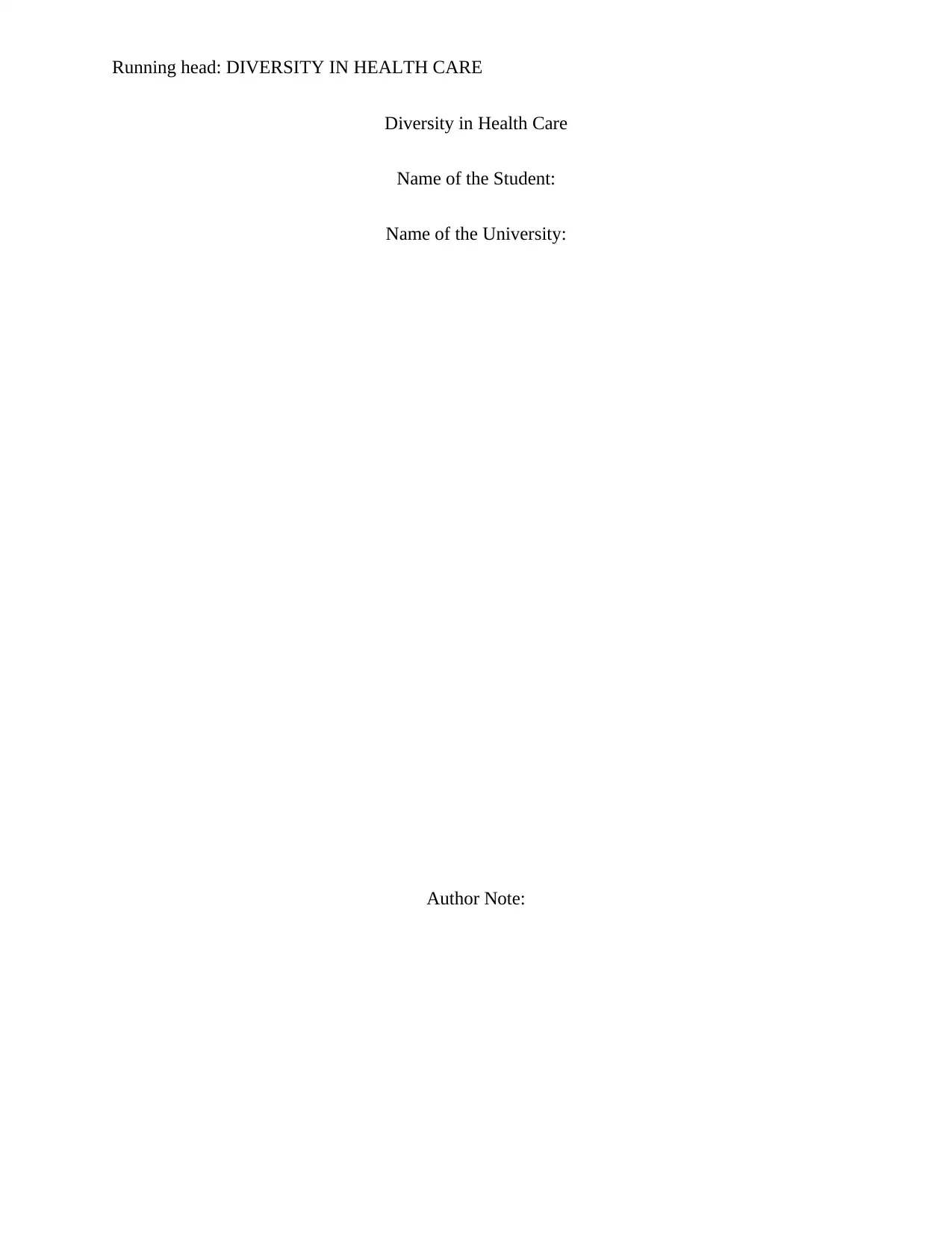
Running head: DIVERSITY IN HEALTH CARE
Diversity in Health Care
Name of the Student:
Name of the University:
Author Note:
Diversity in Health Care
Name of the Student:
Name of the University:
Author Note:
Paraphrase This Document
Need a fresh take? Get an instant paraphrase of this document with our AI Paraphraser
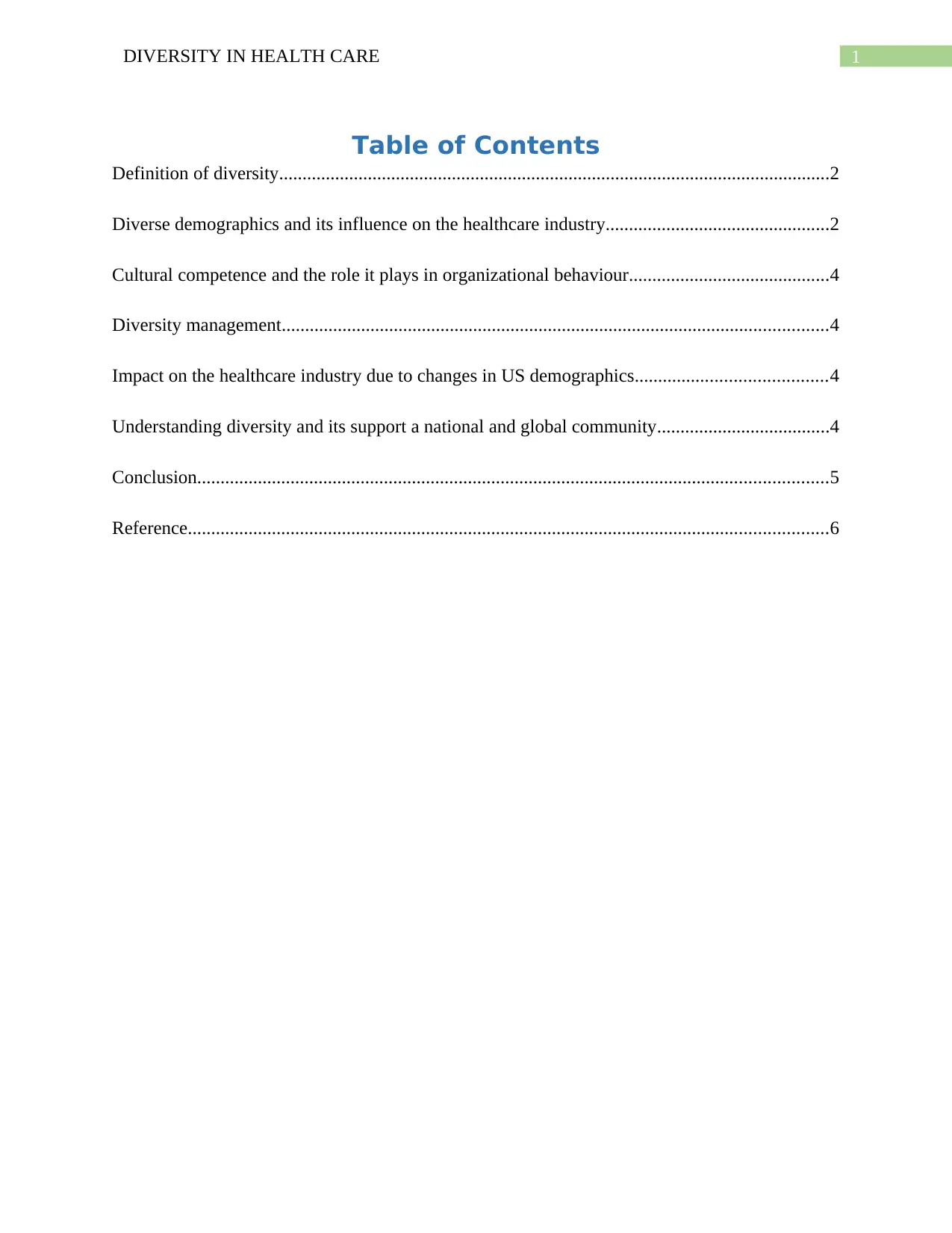
1DIVERSITY IN HEALTH CARE
Table of Contents
Definition of diversity......................................................................................................................2
Diverse demographics and its influence on the healthcare industry................................................2
Cultural competence and the role it plays in organizational behaviour...........................................4
Diversity management.....................................................................................................................4
Impact on the healthcare industry due to changes in US demographics.........................................4
Understanding diversity and its support a national and global community.....................................4
Conclusion.......................................................................................................................................5
Reference.........................................................................................................................................6
Table of Contents
Definition of diversity......................................................................................................................2
Diverse demographics and its influence on the healthcare industry................................................2
Cultural competence and the role it plays in organizational behaviour...........................................4
Diversity management.....................................................................................................................4
Impact on the healthcare industry due to changes in US demographics.........................................4
Understanding diversity and its support a national and global community.....................................4
Conclusion.......................................................................................................................................5
Reference.........................................................................................................................................6
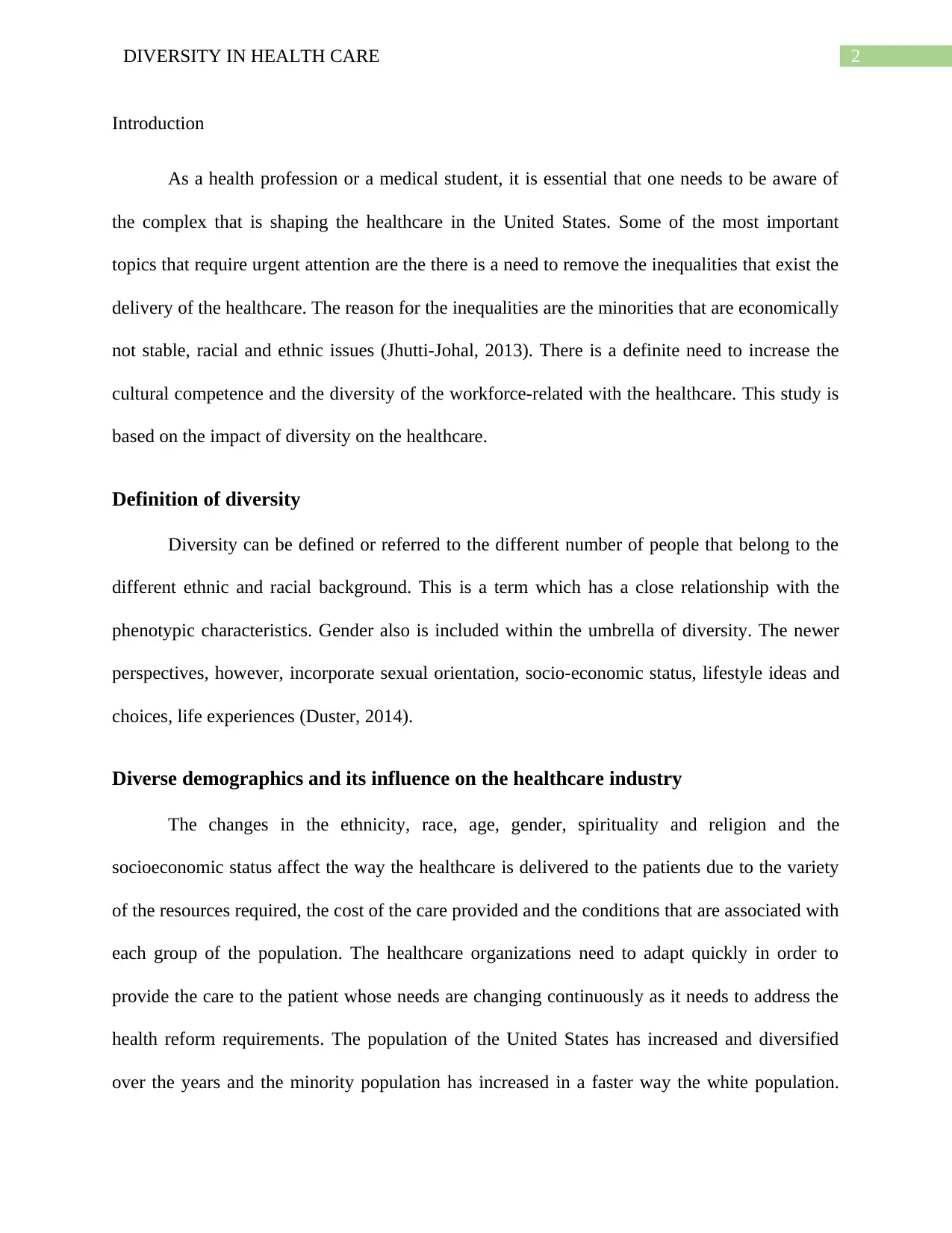
2DIVERSITY IN HEALTH CARE
Introduction
As a health profession or a medical student, it is essential that one needs to be aware of
the complex that is shaping the healthcare in the United States. Some of the most important
topics that require urgent attention are the there is a need to remove the inequalities that exist the
delivery of the healthcare. The reason for the inequalities are the minorities that are economically
not stable, racial and ethnic issues (Jhutti-Johal, 2013). There is a definite need to increase the
cultural competence and the diversity of the workforce-related with the healthcare. This study is
based on the impact of diversity on the healthcare.
Definition of diversity
Diversity can be defined or referred to the different number of people that belong to the
different ethnic and racial background. This is a term which has a close relationship with the
phenotypic characteristics. Gender also is included within the umbrella of diversity. The newer
perspectives, however, incorporate sexual orientation, socio-economic status, lifestyle ideas and
choices, life experiences (Duster, 2014).
Diverse demographics and its influence on the healthcare industry
The changes in the ethnicity, race, age, gender, spirituality and religion and the
socioeconomic status affect the way the healthcare is delivered to the patients due to the variety
of the resources required, the cost of the care provided and the conditions that are associated with
each group of the population. The healthcare organizations need to adapt quickly in order to
provide the care to the patient whose needs are changing continuously as it needs to address the
health reform requirements. The population of the United States has increased and diversified
over the years and the minority population has increased in a faster way the white population.
Introduction
As a health profession or a medical student, it is essential that one needs to be aware of
the complex that is shaping the healthcare in the United States. Some of the most important
topics that require urgent attention are the there is a need to remove the inequalities that exist the
delivery of the healthcare. The reason for the inequalities are the minorities that are economically
not stable, racial and ethnic issues (Jhutti-Johal, 2013). There is a definite need to increase the
cultural competence and the diversity of the workforce-related with the healthcare. This study is
based on the impact of diversity on the healthcare.
Definition of diversity
Diversity can be defined or referred to the different number of people that belong to the
different ethnic and racial background. This is a term which has a close relationship with the
phenotypic characteristics. Gender also is included within the umbrella of diversity. The newer
perspectives, however, incorporate sexual orientation, socio-economic status, lifestyle ideas and
choices, life experiences (Duster, 2014).
Diverse demographics and its influence on the healthcare industry
The changes in the ethnicity, race, age, gender, spirituality and religion and the
socioeconomic status affect the way the healthcare is delivered to the patients due to the variety
of the resources required, the cost of the care provided and the conditions that are associated with
each group of the population. The healthcare organizations need to adapt quickly in order to
provide the care to the patient whose needs are changing continuously as it needs to address the
health reform requirements. The population of the United States has increased and diversified
over the years and the minority population has increased in a faster way the white population.
⊘ This is a preview!⊘
Do you want full access?
Subscribe today to unlock all pages.

Trusted by 1+ million students worldwide
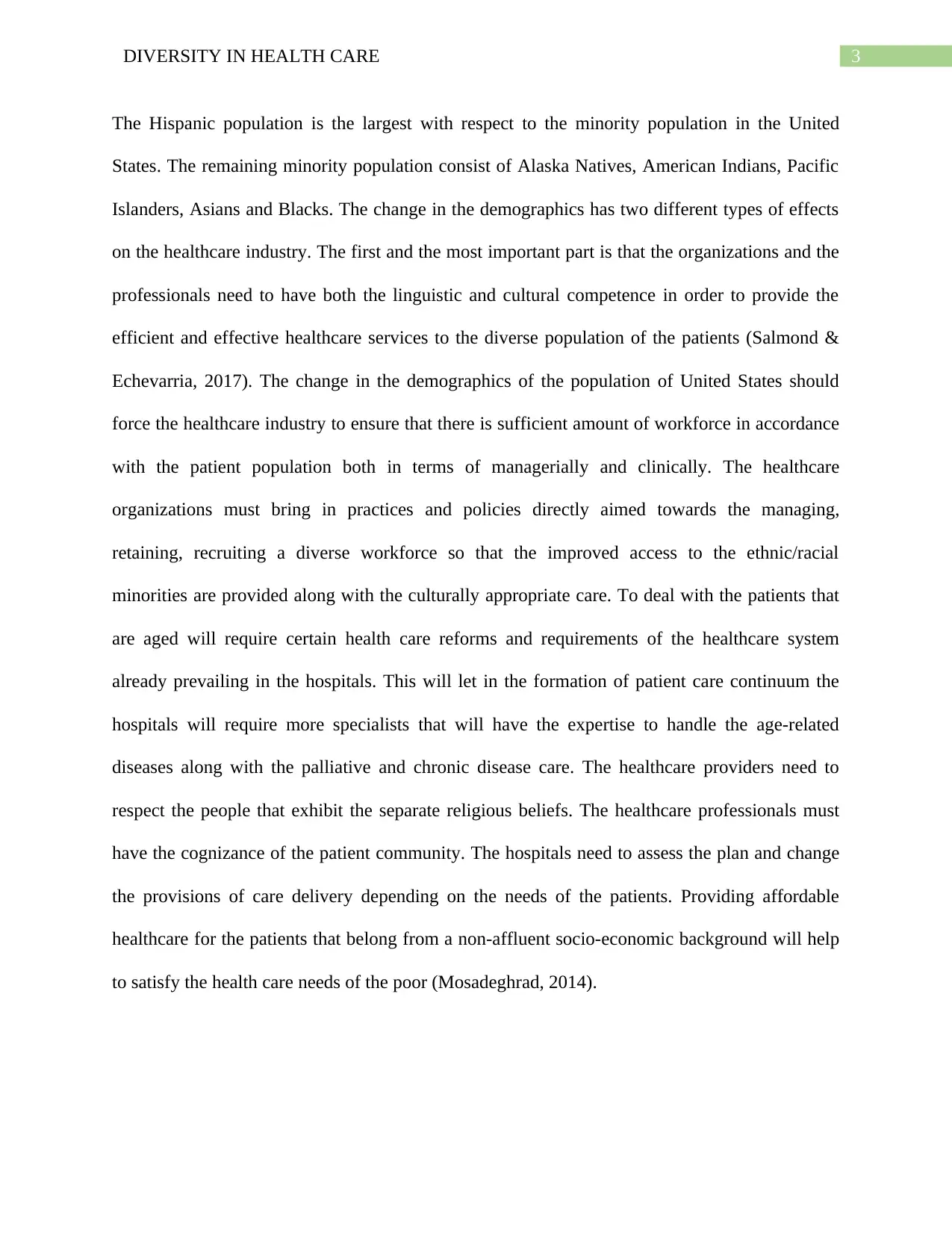
3DIVERSITY IN HEALTH CARE
The Hispanic population is the largest with respect to the minority population in the United
States. The remaining minority population consist of Alaska Natives, American Indians, Pacific
Islanders, Asians and Blacks. The change in the demographics has two different types of effects
on the healthcare industry. The first and the most important part is that the organizations and the
professionals need to have both the linguistic and cultural competence in order to provide the
efficient and effective healthcare services to the diverse population of the patients (Salmond &
Echevarria, 2017). The change in the demographics of the population of United States should
force the healthcare industry to ensure that there is sufficient amount of workforce in accordance
with the patient population both in terms of managerially and clinically. The healthcare
organizations must bring in practices and policies directly aimed towards the managing,
retaining, recruiting a diverse workforce so that the improved access to the ethnic/racial
minorities are provided along with the culturally appropriate care. To deal with the patients that
are aged will require certain health care reforms and requirements of the healthcare system
already prevailing in the hospitals. This will let in the formation of patient care continuum the
hospitals will require more specialists that will have the expertise to handle the age-related
diseases along with the palliative and chronic disease care. The healthcare providers need to
respect the people that exhibit the separate religious beliefs. The healthcare professionals must
have the cognizance of the patient community. The hospitals need to assess the plan and change
the provisions of care delivery depending on the needs of the patients. Providing affordable
healthcare for the patients that belong from a non-affluent socio-economic background will help
to satisfy the health care needs of the poor (Mosadeghrad, 2014).
The Hispanic population is the largest with respect to the minority population in the United
States. The remaining minority population consist of Alaska Natives, American Indians, Pacific
Islanders, Asians and Blacks. The change in the demographics has two different types of effects
on the healthcare industry. The first and the most important part is that the organizations and the
professionals need to have both the linguistic and cultural competence in order to provide the
efficient and effective healthcare services to the diverse population of the patients (Salmond &
Echevarria, 2017). The change in the demographics of the population of United States should
force the healthcare industry to ensure that there is sufficient amount of workforce in accordance
with the patient population both in terms of managerially and clinically. The healthcare
organizations must bring in practices and policies directly aimed towards the managing,
retaining, recruiting a diverse workforce so that the improved access to the ethnic/racial
minorities are provided along with the culturally appropriate care. To deal with the patients that
are aged will require certain health care reforms and requirements of the healthcare system
already prevailing in the hospitals. This will let in the formation of patient care continuum the
hospitals will require more specialists that will have the expertise to handle the age-related
diseases along with the palliative and chronic disease care. The healthcare providers need to
respect the people that exhibit the separate religious beliefs. The healthcare professionals must
have the cognizance of the patient community. The hospitals need to assess the plan and change
the provisions of care delivery depending on the needs of the patients. Providing affordable
healthcare for the patients that belong from a non-affluent socio-economic background will help
to satisfy the health care needs of the poor (Mosadeghrad, 2014).
Paraphrase This Document
Need a fresh take? Get an instant paraphrase of this document with our AI Paraphraser
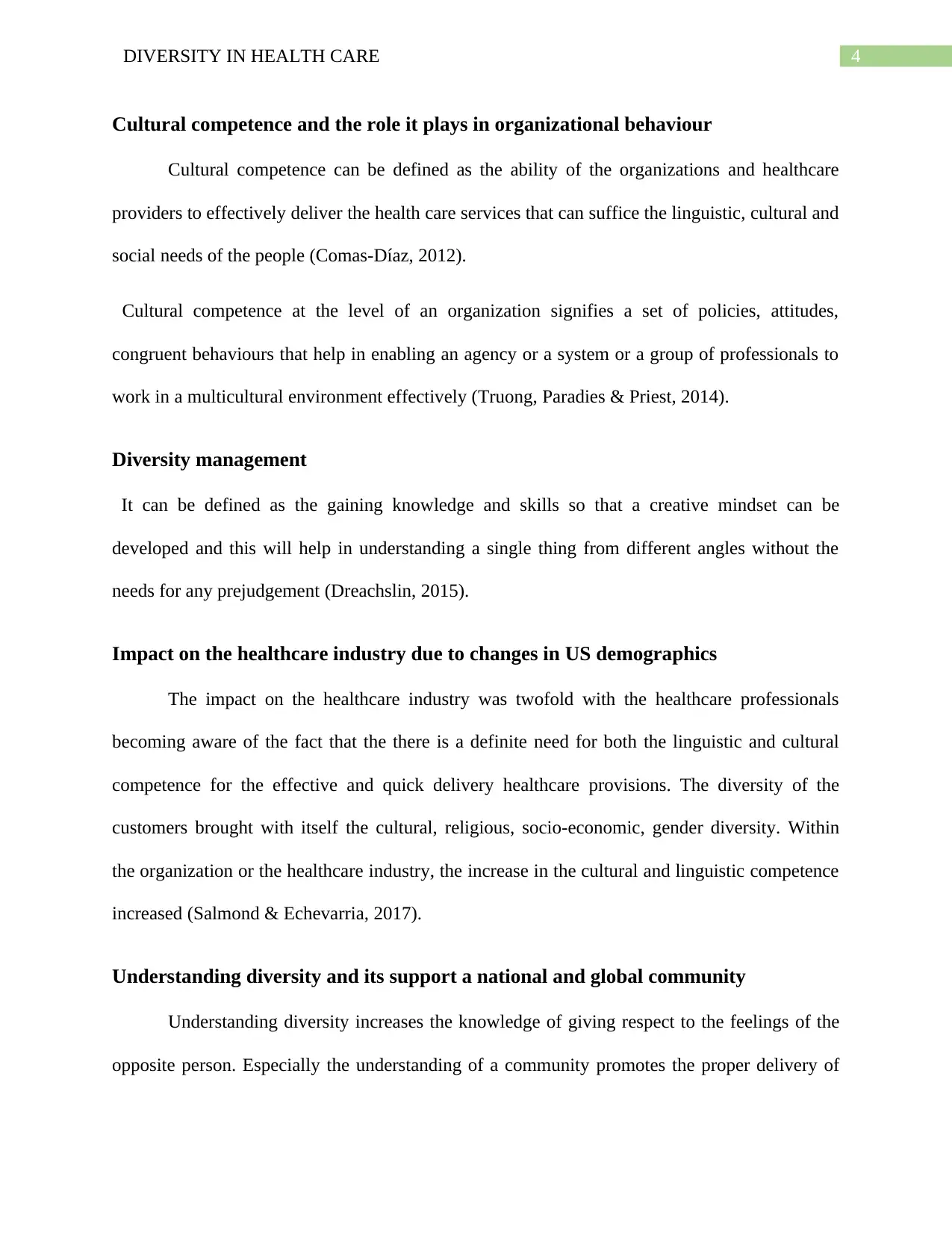
4DIVERSITY IN HEALTH CARE
Cultural competence and the role it plays in organizational behaviour
Cultural competence can be defined as the ability of the organizations and healthcare
providers to effectively deliver the health care services that can suffice the linguistic, cultural and
social needs of the people (Comas-Díaz, 2012).
Cultural competence at the level of an organization signifies a set of policies, attitudes,
congruent behaviours that help in enabling an agency or a system or a group of professionals to
work in a multicultural environment effectively (Truong, Paradies & Priest, 2014).
Diversity management
It can be defined as the gaining knowledge and skills so that a creative mindset can be
developed and this will help in understanding a single thing from different angles without the
needs for any prejudgement (Dreachslin, 2015).
Impact on the healthcare industry due to changes in US demographics
The impact on the healthcare industry was twofold with the healthcare professionals
becoming aware of the fact that the there is a definite need for both the linguistic and cultural
competence for the effective and quick delivery healthcare provisions. The diversity of the
customers brought with itself the cultural, religious, socio-economic, gender diversity. Within
the organization or the healthcare industry, the increase in the cultural and linguistic competence
increased (Salmond & Echevarria, 2017).
Understanding diversity and its support a national and global community
Understanding diversity increases the knowledge of giving respect to the feelings of the
opposite person. Especially the understanding of a community promotes the proper delivery of
Cultural competence and the role it plays in organizational behaviour
Cultural competence can be defined as the ability of the organizations and healthcare
providers to effectively deliver the health care services that can suffice the linguistic, cultural and
social needs of the people (Comas-Díaz, 2012).
Cultural competence at the level of an organization signifies a set of policies, attitudes,
congruent behaviours that help in enabling an agency or a system or a group of professionals to
work in a multicultural environment effectively (Truong, Paradies & Priest, 2014).
Diversity management
It can be defined as the gaining knowledge and skills so that a creative mindset can be
developed and this will help in understanding a single thing from different angles without the
needs for any prejudgement (Dreachslin, 2015).
Impact on the healthcare industry due to changes in US demographics
The impact on the healthcare industry was twofold with the healthcare professionals
becoming aware of the fact that the there is a definite need for both the linguistic and cultural
competence for the effective and quick delivery healthcare provisions. The diversity of the
customers brought with itself the cultural, religious, socio-economic, gender diversity. Within
the organization or the healthcare industry, the increase in the cultural and linguistic competence
increased (Salmond & Echevarria, 2017).
Understanding diversity and its support a national and global community
Understanding diversity increases the knowledge of giving respect to the feelings of the
opposite person. Especially the understanding of a community promotes the proper delivery of
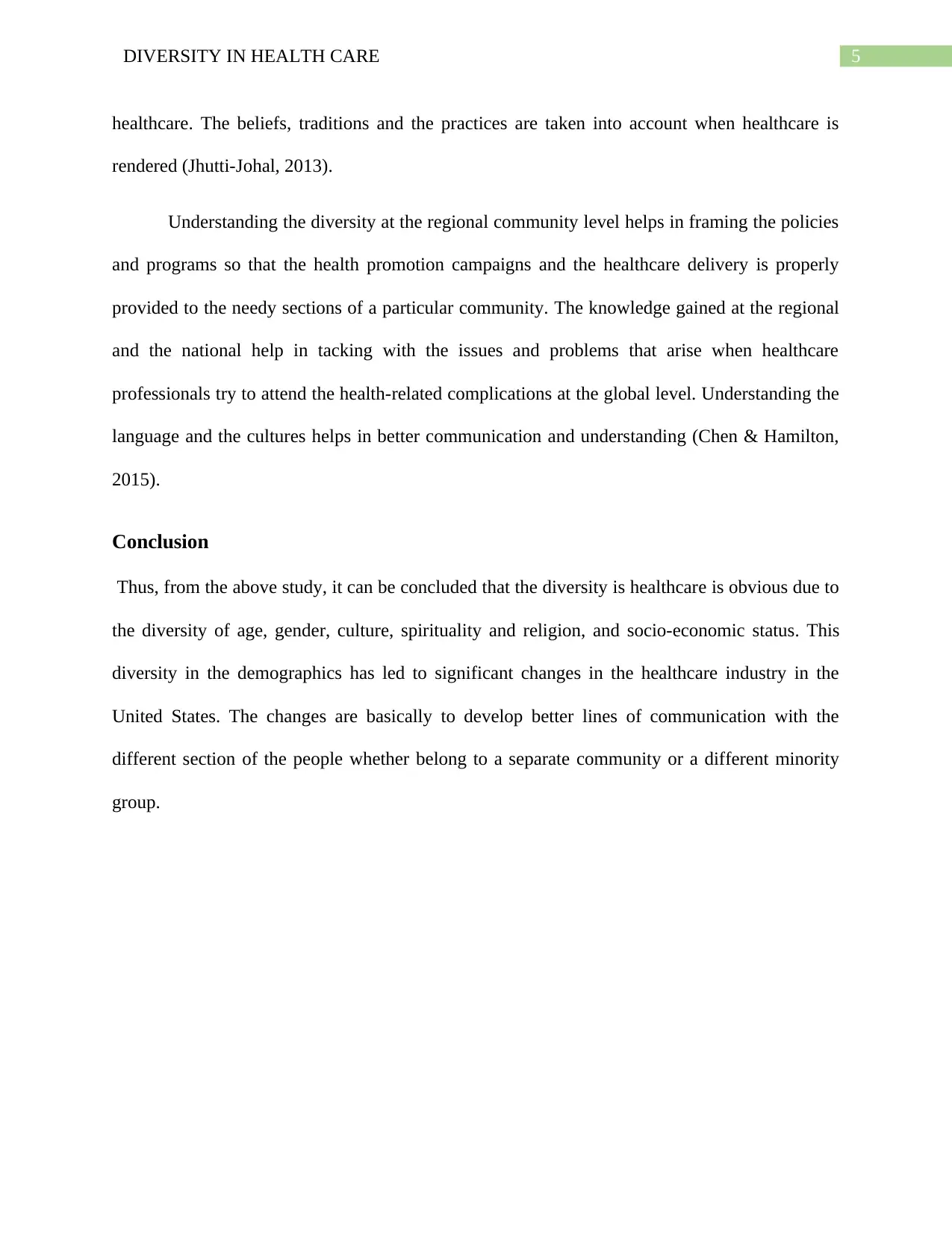
5DIVERSITY IN HEALTH CARE
healthcare. The beliefs, traditions and the practices are taken into account when healthcare is
rendered (Jhutti-Johal, 2013).
Understanding the diversity at the regional community level helps in framing the policies
and programs so that the health promotion campaigns and the healthcare delivery is properly
provided to the needy sections of a particular community. The knowledge gained at the regional
and the national help in tacking with the issues and problems that arise when healthcare
professionals try to attend the health-related complications at the global level. Understanding the
language and the cultures helps in better communication and understanding (Chen & Hamilton,
2015).
Conclusion
Thus, from the above study, it can be concluded that the diversity is healthcare is obvious due to
the diversity of age, gender, culture, spirituality and religion, and socio-economic status. This
diversity in the demographics has led to significant changes in the healthcare industry in the
United States. The changes are basically to develop better lines of communication with the
different section of the people whether belong to a separate community or a different minority
group.
healthcare. The beliefs, traditions and the practices are taken into account when healthcare is
rendered (Jhutti-Johal, 2013).
Understanding the diversity at the regional community level helps in framing the policies
and programs so that the health promotion campaigns and the healthcare delivery is properly
provided to the needy sections of a particular community. The knowledge gained at the regional
and the national help in tacking with the issues and problems that arise when healthcare
professionals try to attend the health-related complications at the global level. Understanding the
language and the cultures helps in better communication and understanding (Chen & Hamilton,
2015).
Conclusion
Thus, from the above study, it can be concluded that the diversity is healthcare is obvious due to
the diversity of age, gender, culture, spirituality and religion, and socio-economic status. This
diversity in the demographics has led to significant changes in the healthcare industry in the
United States. The changes are basically to develop better lines of communication with the
different section of the people whether belong to a separate community or a different minority
group.
⊘ This is a preview!⊘
Do you want full access?
Subscribe today to unlock all pages.

Trusted by 1+ million students worldwide
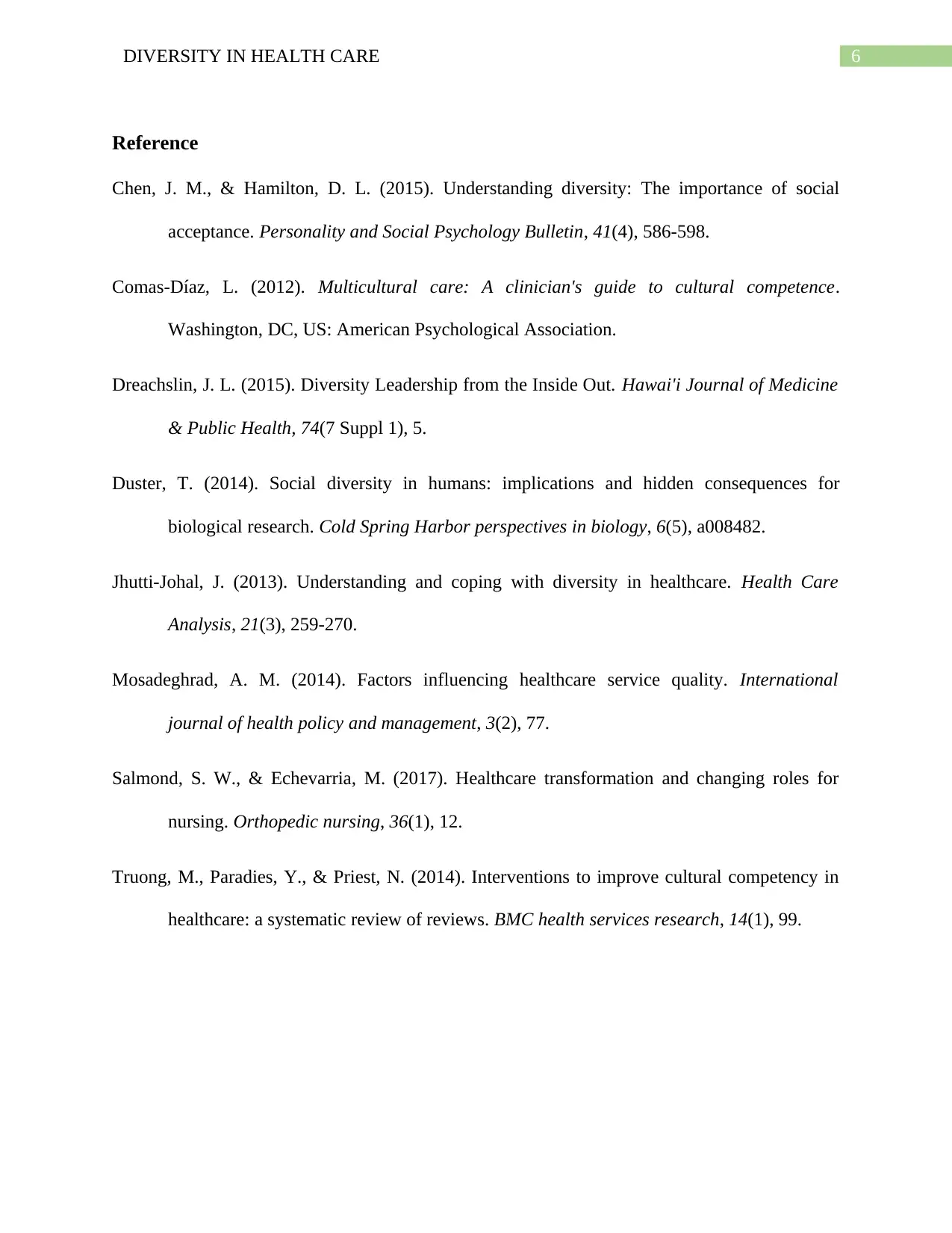
6DIVERSITY IN HEALTH CARE
Reference
Chen, J. M., & Hamilton, D. L. (2015). Understanding diversity: The importance of social
acceptance. Personality and Social Psychology Bulletin, 41(4), 586-598.
Comas-Díaz, L. (2012). Multicultural care: A clinician's guide to cultural competence.
Washington, DC, US: American Psychological Association.
Dreachslin, J. L. (2015). Diversity Leadership from the Inside Out. Hawai'i Journal of Medicine
& Public Health, 74(7 Suppl 1), 5.
Duster, T. (2014). Social diversity in humans: implications and hidden consequences for
biological research. Cold Spring Harbor perspectives in biology, 6(5), a008482.
Jhutti-Johal, J. (2013). Understanding and coping with diversity in healthcare. Health Care
Analysis, 21(3), 259-270.
Mosadeghrad, A. M. (2014). Factors influencing healthcare service quality. International
journal of health policy and management, 3(2), 77.
Salmond, S. W., & Echevarria, M. (2017). Healthcare transformation and changing roles for
nursing. Orthopedic nursing, 36(1), 12.
Truong, M., Paradies, Y., & Priest, N. (2014). Interventions to improve cultural competency in
healthcare: a systematic review of reviews. BMC health services research, 14(1), 99.
Reference
Chen, J. M., & Hamilton, D. L. (2015). Understanding diversity: The importance of social
acceptance. Personality and Social Psychology Bulletin, 41(4), 586-598.
Comas-Díaz, L. (2012). Multicultural care: A clinician's guide to cultural competence.
Washington, DC, US: American Psychological Association.
Dreachslin, J. L. (2015). Diversity Leadership from the Inside Out. Hawai'i Journal of Medicine
& Public Health, 74(7 Suppl 1), 5.
Duster, T. (2014). Social diversity in humans: implications and hidden consequences for
biological research. Cold Spring Harbor perspectives in biology, 6(5), a008482.
Jhutti-Johal, J. (2013). Understanding and coping with diversity in healthcare. Health Care
Analysis, 21(3), 259-270.
Mosadeghrad, A. M. (2014). Factors influencing healthcare service quality. International
journal of health policy and management, 3(2), 77.
Salmond, S. W., & Echevarria, M. (2017). Healthcare transformation and changing roles for
nursing. Orthopedic nursing, 36(1), 12.
Truong, M., Paradies, Y., & Priest, N. (2014). Interventions to improve cultural competency in
healthcare: a systematic review of reviews. BMC health services research, 14(1), 99.
Paraphrase This Document
Need a fresh take? Get an instant paraphrase of this document with our AI Paraphraser
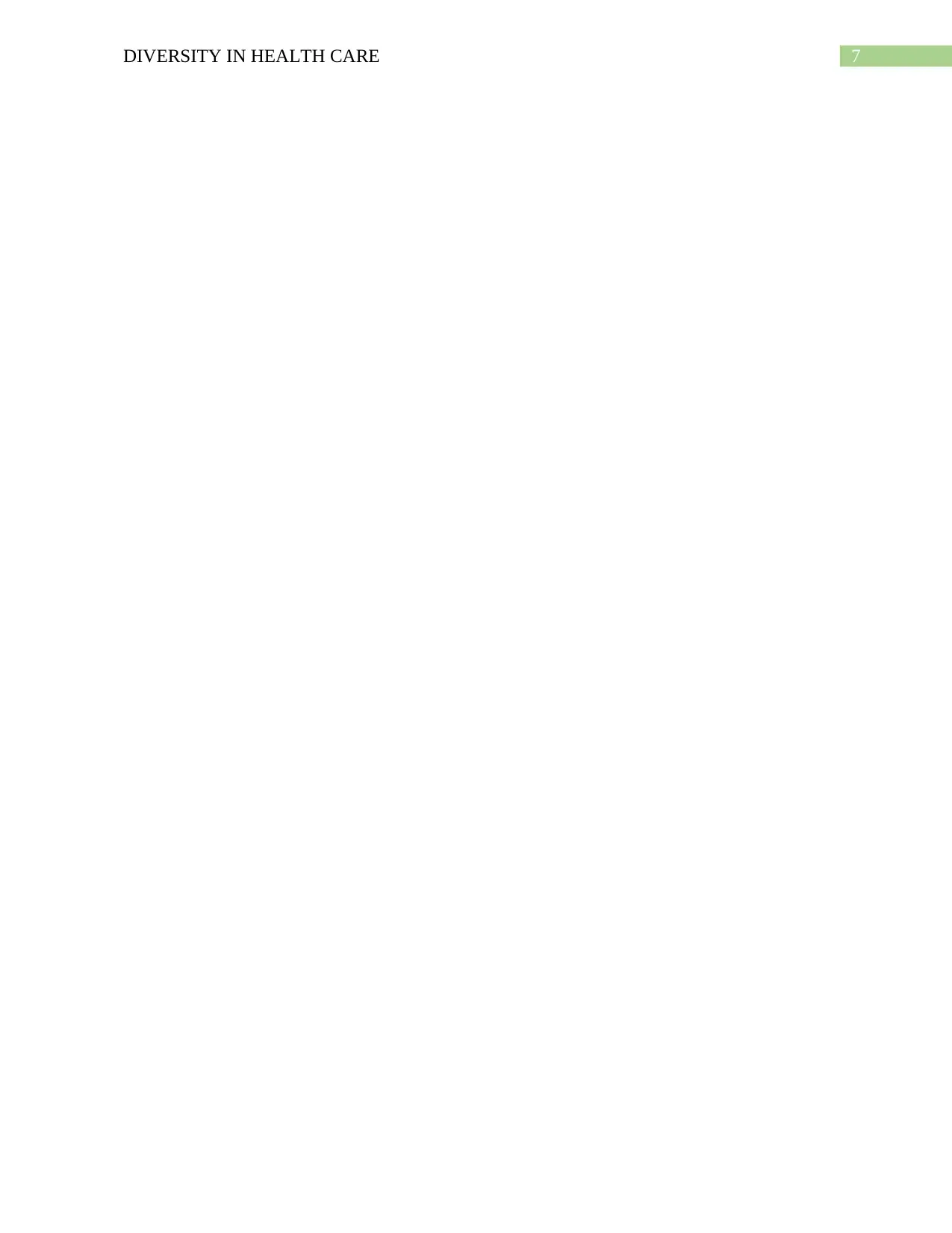
7DIVERSITY IN HEALTH CARE
1 out of 8
Related Documents
Your All-in-One AI-Powered Toolkit for Academic Success.
+13062052269
info@desklib.com
Available 24*7 on WhatsApp / Email
![[object Object]](/_next/static/media/star-bottom.7253800d.svg)
Unlock your academic potential
Copyright © 2020–2025 A2Z Services. All Rights Reserved. Developed and managed by ZUCOL.





